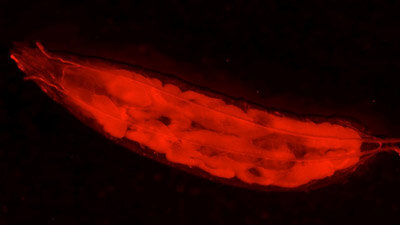Fly larvae reared on a low-tyrosine diet activate genes (shown in red) that suppress protein metabolism. Credit: RIKEN Center for Biosystems and Dynamics Research
A “non-essential” amino acid, so called because the body can make it from other nutrients, can act as a nutritional signal to guide the body’s responses to a low-protein diet, a RIKEN-led team found in a study. on fruit fly larvae. If a similar control mechanism operates in mammals, it may be possible to use it to control appetite.
To help us decide whether to eat another helping of meat or fish, our brains have developed mechanisms to detect changes in the body’s protein building blocks and adjust our intake of protein-rich foods accordingly. Researchers had long assumed that this process depended only on those building blocksknown as amino acidsthat the body cannot produce naturally on its own.
But now, a RIKEN-led study has found that’s not always the case. “We have discovered a new mechanism for sensing and adapting to protein shortages in the diet,” says Fumiaki Obata of the RIKEN Center for Biosystems and Dynamics Research (BDR).
known as tyrosinethe amino acid is found in dairy products, meats, nuts, beans, and other high-protein foods. But the body can also synthesize tyrosine from another amino acid called phenylalanine, which is similarly found in both plant and animal foods.
As Obata and his BDR colleague Hina Kosakamoto have now shown, flies slow their rate of protein metabolism and increase food consumption when dietary tyrosine levels are low, a sign of adaptation to protein shortages. But, on the contrary, when tyrosine is ingested in larger quantities, the flies speed up their protein metabolism. They also limit extra protein intake, thus ensuring that levels of the macronutrient remain within a healthy range.
The team identified several of the molecular players and signaling pathways involved in regulating the body’s response to tyrosine levels, although exactly how this happens remains unclear. They ruled out a common mechanism by which the brain detects nutrient imbalances. But as Kosakamoto points out, “we still don’t know how tyrosine is detected in cells.”
Another research priority for the team is to corroborate the findings in mouse models. This will help determine how relevant the results are to Human physiology and medicine, as well as for agriculture and livestock. “If tyrosine plays a similar role in mammals, then we could use tyrosine restriction to control appetite, treat metabolic syndrome or even prevent aging,” Obata says. “Potentially, our knowledge could also be applied in the livestock industry to improve animal health and production.”
The study is published in Nature Metabolism.
Many drugs have mirror image chemical structures: while one may be helpful, the other may be harmful
Hina Kosakamoto et al, Detection of the non-essential amino acid tyrosine governs the response to protein restriction in Drosophila, Nature Metabolism (2022). DOI: 10.1038/s42255-022-00608-7
Citation: ‘Non-essential’ Building Block Proves Vital to Healthy Protein Diet (2022, Oct 17) Retrieved Oct 18, 2022 from https://phys.org/news/2022-10-non-essential- block-vital-healthy-protein.html
This document is subject to copyright. Other than any fair dealing for private study or research purposes, no part may be reproduced without written permission. The content is provided for informational purposes only.
